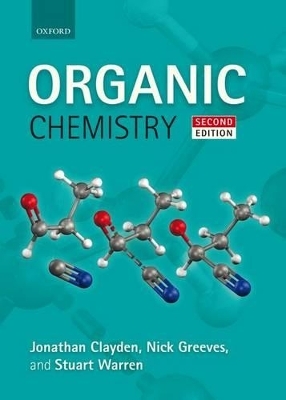
Organic Chemistry
Oxford University Press (Verlag)
978-0-19-927029-3 (ISBN)
Inspiring and motivating students from the moment it published, Organic Chemistry has established itself in just one edition as the students' choice of organic chemistry text.
This second edition takes all that has made Organic Chemistry the book of choice, and has refined and refocused it to produce a text that is even more student-friendly, more coherent and more logical in its presentation than before.
At heart, the second edition remains true to the first, being built on three principles:
An explanatory approach, through which the reader is motivated to understand the subject and not just learn the facts;
A mechanistic approach, giving the reader the power to understand compounds and reactions never previously encountered;
An evidence-based approach, setting out clearly how and why reactions happen as they do, giving extra depth to the reader's understanding.
The authors write clearly and directly, sharing with the reader their own fascination with the subject, and leading them carefully from topic to topic. Their honest and open narrative flags pitfalls and misconceptions, guiding the reader towards a complete picture of organic chemistry and its universal themes and principles.
Enriched with an extensive bank of online resources to help the reader visualise the structure of organic compounds and their reaction mechanisms, this second edition reaffirms the position of Organic Chemistry as the essential course companion for all organic chemistry students.
Online Resource Centre
For students:
A range of problems to accompany each chapter
For registered adopters of the text:
Figures from the book in electronic format
Jonathan Clayden is a Professor of Organic Chemistry at the University of Manchester, where he and his research group work on the construction of molecules with defined shapes - in particular those where control of conformation and limitation of flexibility is important. Jonathan was awarded a BA (Natural Sciences) from Churchill College, Cambridge before completing his PhD with Stuart Warren, also at the University of Cambridge. He has been at the University of Manchester since 1994. Nick Greeves is the Director of Teaching and Learning in the Department of Chemistry at the University of Liverpool. Nick is a Cambridge graduate, obtaining his PhD there in 1986 for work on the stereoselective Horner-Wittig reaction with Stuart Warren. He then held a Harkness Fellowship at the University of Wisconsin-Madison and at Stanford University, California, and a Research Fellowship at Cambridge University before joining Liverpool in 1989 where he is currently a Senior Lecturer. Stuart Warren is a former lecturer in the Department of Chemistry at the University of Cambridge and Fellow of Churchill College, Cambridge. A graduate of Trinity College, Cambridge, Stuart completed his PhD at Cambridge with Malcolm Clark before carrying out post-doctoral research at Harvard University. He became a teaching fellow at Churchill College in 1971, and remained a lecturer and researcher at Cambridge until his retirement in 2006.
1. What is organic chemistry? ; 2. Organic structures ; 3. Determining organic structures ; 4. Structure of molecules ; 5. Organic reactions ; 6. Nucleophilic addition to the carbonyl group ; 7. Delocalization and conjugation ; 8. Acidity, basicity, and pKa ; 9. Using organometallic reagents to make C-C bonds ; 10. Nucleophilic substitution at the carbonyl group ; 11. Nucleophilic substitution at C=O with loss of carbonyl oxygen ; 12. Equilibria, rates and mechanisms ; 13. 1H NMR: Proton nuclear magnetic resonance ; 14. Stereochemistry ; 15. Nucleophilic substitution at saturated carbon ; 16. Conformational analysis ; 17. Elimination reactions ; 18. Review of spectroscopic methods ; 19. Electrophilic addition to alkenes ; 20. Formation and reactions of enols and enolates ; 21. Electrophilic aromatic substitution ; 22. Conjugate addition and nucleophilic aromatic substitution ; 23. Chemoselectivity and protecting groups ; 24. Regioselectivity ; 25. Alkylation of enolates ; 26. Reactions of enolates with carbonyl compounds: the aldol and Claisen reactions ; 27. Sulfur, silicon and phosphorus in organic chemistry ; 28. Retrosynthetic analysis ; 29. Aromatic heterocycles 1: structures and reactions ; 30. Aromatic heterocycles 2: synthesis ; 31. Saturated heterocycles and stereoelectronics ; 32. Stereoselectivity in cyclic molecules ; 33. Diastereoselectivity ; 34. Pericyclic reactions 1: cycloadditions ; 35. Pericyclic reactions 2: sigmatropic and electrocyclic reactions ; 36. Participation, rearrangement and fragmentation ; 37. Radical reactions ; 38. Synthesis and reactions of carbenes ; 39. Determining reaction mechanisms ; 40. Organometallic chemistry ; 41. Asymmetric synthesis ; 42. Organic chemistry of life ; 43. Organic chemistry today
| Erscheint lt. Verlag | 15.3.2012 |
|---|---|
| Zusatzinfo | 3600 colour line drawings |
| Verlagsort | Oxford |
| Sprache | englisch |
| Maße | 199 x 275 mm |
| Gewicht | 2481 g |
| Themenwelt | Naturwissenschaften ► Chemie ► Organische Chemie |
| ISBN-10 | 0-19-927029-5 / 0199270295 |
| ISBN-13 | 978-0-19-927029-3 / 9780199270293 |
| Zustand | Neuware |
| Haben Sie eine Frage zum Produkt? |
aus dem Bereich


